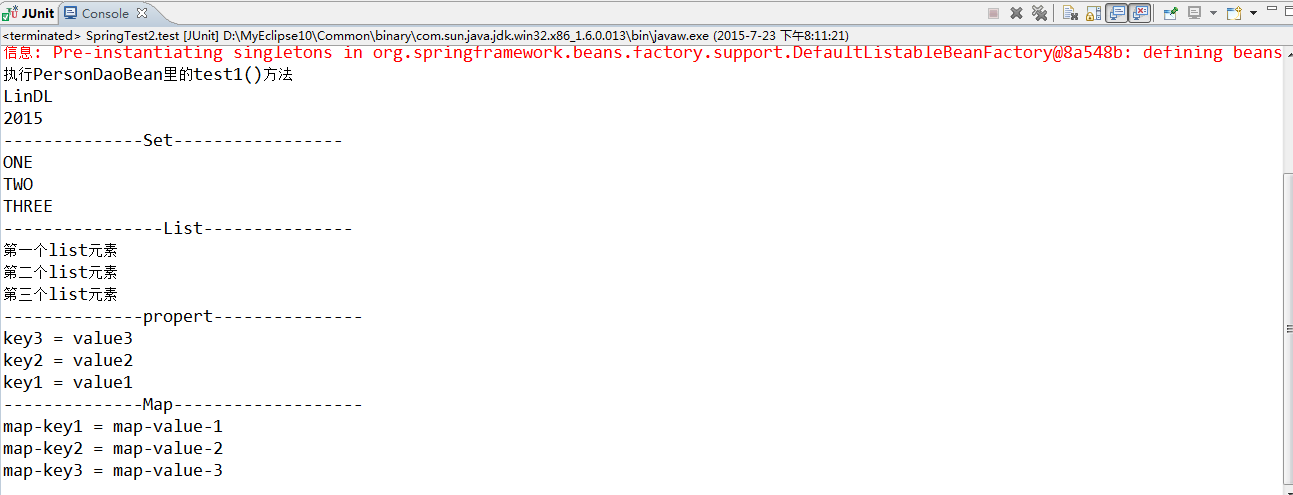Spring(五)依赖注入原理及多种数据类型的装配
2015-07-23 16:23
543 查看
基本类型对象注入

编码剖析依赖注入原理
package test.spring.dao;
public interface PersonDao {
public abstract void add();
}package test.spring.dao.impl;
import test.spring.dao.PersonDao;
public class PersonDaoBean implements PersonDao {
@Override
public void add(){
System.out.println("执行PersonDaoBean里的test1()方法");
}
}package test.spring.service;
import java.util.List;
import java.util.Map;
import java.util.Properties;
import java.util.Set;
public interface PersonService {
public abstract void save();
public Set<String> getSet();
public List<String> getList();
public Properties getProperties();
public Map<String, String> getMap();
}package test.spring.service.impl;
import java.util.ArrayList;
import java.util.HashMap;
import java.util.HashSet;
import java.util.List;
import java.util.Map;
import java.util.Properties;
import java.util.Set;
import test.spring.dao.PersonDao;
import test.spring.entity.Property;
import test.spring.service.PersonService;
public class PersonServiceBean2 implements PersonService {
private PersonDao personDao;
private String name;
private Integer num;
private Set<String> set = new HashSet<String>();
private List<String> list = new ArrayList<String>();
private Properties properties = new Properties();
private Map<String, String> map = new HashMap<String, String>();
public Map<String, String> getMap() {
return map;
}
public void setMap(Map<String, String> map) {
this.map = map;
}
public Properties getProperties() {
return properties;
}
public void setProperties(Properties properties) {
this.properties = properties;
}
public List<String> getList() {
return list;
}
public void setList(List<String> list) {
this.list = list;
}
public Set<String> getSet() {
return set;
}
public void setSet(Set<String> set) {
this.set = set;
}
public Integer getNum() {
return num;
}
public void setNum(Integer num) {
this.num = num;
}
public String getName() {
return name;
}
public void setName(String name) {
this.name = name;
}
public PersonDao getPersonDao() {
return personDao;
}
public void setPersonDao(PersonDao personDao) {
this.personDao = personDao;
}
@Override
public void save() {
personDao.add();
System.out.println(name);
System.out.println(num);
}
}<?xml version="1.0" encoding="UTF-8"?> <beans xmlns="http://www.springframework.org/schema/beans" xmlns:xsi="http://www.w3.org/2001/XMLSchema-instance" xsi:schemaLocation="http://www.springframework.org/schema/beans http://www.springframework.org/schema/beans/spring-beans-2.5.xsd"> <!-- 这时候这个bean就可以由spring帮我们创建和维护,用到时只需从spring容器中获取 --> <!-- <bean id="personService" class="test.spring.service.impl.PersonServiceBean" lazy-init="false" init-method="init" destroy-method="destroy"> </bean> --> <!-- <bean id="personService2" class="test.spring.service.impl.PersonServiceBeanFactory" factory-method="createPersonServiceBean"></bean> <bean id="personServiceFactory" class="test.spring.service.impl.PersonServiceBeanFactory"> </bean> <bean id="personService3" factory-bean="personServiceFactory" factory-method="createPersonServiceBean2"> </bean> --> <!-- 基本类型对象注入 --> <!-- <bean id="personDao" class="test.spring.dao.impl.PersonDaoBean"></bean> <bean id="personService" class="test.spring.service.impl.PersonServiceBean2"> --> <!-- name是service中对于的属性名,ref是对于的bean --> <!-- <property name="personDao" ref="personDao"></property> </bean> --> <!-- 使用内部bean,但该bean不能被其他bean使用 --> <bean id="personDao" class="test.spring.dao.impl.PersonDaoBean" /> <bean id="personService" class="test.spring.service.impl.PersonServiceBean2"> <!-- name是service中对于的属性名,ref是对于的bean --> <property name="personDao" ref="personDao" /> <!-- 为基本数据类型注入值 --> <property name="name" value="LinDL" /> <property name="num" value="2015" /> <property name="set"> <set> <value>ONE</value> <value>TWO</value> <value>THREE</value> </set> </property> <property name="list"> <list> <value>第一个list元素</value> <value>第二个list元素</value> <value>第三个list元素</value> </list> </property> <property name="properties"> <props> <prop key="key1">value1</prop> <prop key="key2">value2</prop> <prop key="key3">value3</prop> </props> </property> <property name="map"> <map> <entry key="map-key1" value="map-value-1" /> <entry key="map-key2" value="map-value-2" /> <entry key="map-key3" value="map-value-3" /> </map> </property> </bean> </beans>
package test.spring.jnit;
import org.junit.Test;
import org.springframework.context.ApplicationContext;
import org.springframework.context.support.ClassPathXmlApplicationContext;
import test.spring.service.PersonService;
public class SpringTest2 {
@Test
public void test() {
ApplicationContext applicationContext = new ClassPathXmlApplicationContext(
"beans.xml");
PersonService personService=(PersonService) applicationContext.getBean("personService");
personService.save();
System.out.println("--------------Set-----------------");
for(String str:personService.getSet()){
System.out.println(str);
}
System.out.println("----------------List---------------");
for(String str:personService.getList()){
System.out.println(str);
}
System.out.println("--------------propert---------------");
for(Object key:personService.getProperties().keySet()){
System.out.println(key+" = "+personService.getProperties().getProperty((String) key));
}
System.out.println("--------------Map-------------------");
for(String key:personService.getMap().keySet()){
System.out.println(key+" = "+personService.getMap().get(key));
}
// InjectTest injectTest=new InjectTest("beans.xml");
// PersonService personService=(PersonService) injectTest.getBean("personService");
// personService.save();
}
}
编码剖析依赖注入原理
package test.spring.entity;
import java.util.ArrayList;
import java.util.List;
public class Bean2 {
private String id;
private String classPath;
private List<Property> properties=new ArrayList<Property>();
public Bean2(String id, String classPath) {
this.id = id;
this.classPath = classPath;
}
public String getId() {
return id;
}
public void setId(String id) {
this.id = id;
}
public String getClassPath() {
return classPath;
}
public void setClassPath(String classPath) {
this.classPath = classPath;
}
public List<Property> getProperties() {
return properties;
}
public void setProperties(List<Property> properties) {
this.properties = properties;
}
}package test.spring.entity;
public class Property {
private String name;
private String ref;
private String value;
public Property(String name, String ref, String value) {
super();
this.name = name;
this.ref = ref;
this.value = value;
}
public String getName() {
return name;
}
public void setName(String name) {
this.name = name;
}
public String getRef() {
return ref;
}
public void setRef(String ref) {
this.ref = ref;
}
public String getValue() {
return value;
}
public void setValue(String value) {
this.value = value;
}
}<pre name="code" class="java">package test.spring.jnit;
import java.beans.Introspector;
import java.beans.PropertyDescriptor;
import java.net.URL;
import java.util.ArrayList;
import java.util.HashMap;
import java.util.List;
import java.util.Map;
import org.apache.commons.beanutils.ConvertUtils;
import org.dom4j.Document;
import org.dom4j.Element;
import org.dom4j.XPath;
import org.dom4j.io.SAXReader;
import org.springframework.asm.commons.Method;
import test.spring.entity.Bean;
import test.spring.entity.Bean2;
import test.spring.entity.Property;
public class InjectTest {
private List<Bean2> beanDefines = new ArrayList<Bean2>();
private Map<String, Object> singletons = new HashMap<String, Object>();
public InjectTest(String filename){
this.readXML(filename);
this.instanceBeans();
this.injectObject();
}
/**
* 为bean对象的属性注入值
*/
private void injectObject() {
for(Bean2 beanDefinition : beanDefines){
Object bean = singletons.get(beanDefinition.getId());
if(bean!=null){
try {
PropertyDescriptor[] ps = Introspector.getBeanInfo(bean.getClass()).getPropertyDescriptors();
for(Property propertyDefinition : beanDefinition.getProperties()){
for(PropertyDescriptor properdesc : ps){
if(propertyDefinition.getName().equals(properdesc.getName())){
java.lang.reflect.Method setter = properdesc.getWriteMethod();//获取属性的setter方法 ,private
if(setter!=null){
Object value = null;
if(propertyDefinition.getRef()!=null && !"".equals(propertyDefinition.getRef().trim())){
value = singletons.get(propertyDefinition.getRef());
}else{
value = ConvertUtils.convert(propertyDefinition.getValue(), properdesc.getPropertyType());
}
setter.setAccessible(true);
setter.invoke(bean, value);//把引用对象注入到属性
}
break;
}
}
}
} catch (Exception e) {
}
}
}
}
/**
* 完成bean的实例化
*/
private void instanceBeans() {
for(Bean2 beanDefinition : beanDefines){
try {
if(beanDefinition.getClassPath()!=null && !"".equals(beanDefinition.getClassPath().trim()))
singletons.put(beanDefinition.getId(), Class.forName(beanDefinition.getClassPath()).newInstance());
} catch (Exception e) {
e.printStackTrace();
}
}
}
/**
* 读取xml配置文件
* @param filename
*/
private void readXML(String filename) {
SAXReader saxReader = new SAXReader();
Document document=null;
try{
URL xmlpath = this.getClass().getClassLoader().getResource(filename);
document = saxReader.read(xmlpath);
Map<String,String> nsMap = new HashMap<String,String>();
nsMap.put("ns","http://www.springframework.org/schema/beans");//加入命名空间
XPath xsub = document.createXPath("//ns:beans/ns:bean");//创建beans/bean查询路径
xsub.setNamespaceURIs(nsMap);//设置命名空间
List<Element> beans = xsub.selectNodes(document);//获取文档下所有bean节点
for(Element element: beans){
String id = element.attributeValue("id");//获取id属性值
String clazz = element.attributeValue("class"); //获取class属性值
Bean2 beanDefine = new Bean2(id, clazz);
XPath propertysub = element.createXPath("ns:property");
propertysub.setNamespaceURIs(nsMap);//设置命名空间
List<Element> propertys = propertysub.selectNodes(element);
for(Element property : propertys){
String propertyName = property.attributeValue("name");
String propertyref = property.attributeValue("ref");
String propertyValue = property.attributeValue("value");
Property propertyDefinition = new Property(propertyName, propertyref, propertyValue);
beanDefine.getProperties().add(propertyDefinition);
}
beanDefines.add(beanDefine);
}
}catch(Exception e){
e.printStackTrace();
}
}
/**
* 获取bean实例
* @param beanName
* @return
*/
public Object getBean(String beanName){
return this.singletons.get(beanName);
}
}相关文章推荐
- 在eclipse中导出javadoc报"错误: 编码GBK的不可映射字符"解决办法
- 【struts2】action中使用通配符
- struts2 action通配符
- java项目开发的一些准备工作
- springmvc ajax 请求后台报400 错误
- 【sdk】Eclipse更新sdk,设置红杏公益代理
- 基于JAVA的聊天室开发
- java(TM)2 platform 运行 jar 一闪而过
- Thinking In Java<<Java编程思想>>
- CCF 竞价集合 Java实现
- 求1~100间的素数.java
- Java程序理解
- JAVA 虚拟机内存
- Maven+SpringMVC整合之helloworld
- super与this的异同
- Java通过FTP服务器上传下载文件的方法
- Java语言基础
- eclipse的使用技巧(一)
- 构建高性能高并发Java系统
- JAVA集成开发环境与JDK
